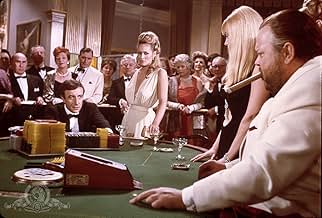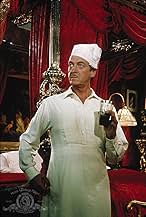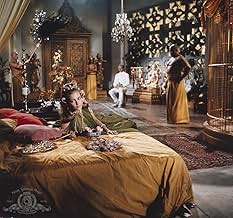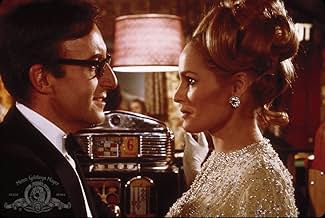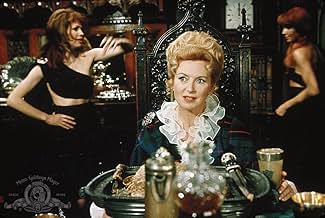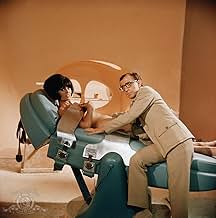AVALIAÇÃO DA IMDb
5,0/10
34 mil
SUA AVALIAÇÃO
Em uma das primeiras paródias de filmes de espionagem, James Bond abandona sua aposentadoria para enfrentar a SMERSH.Em uma das primeiras paródias de filmes de espionagem, James Bond abandona sua aposentadoria para enfrentar a SMERSH.Em uma das primeiras paródias de filmes de espionagem, James Bond abandona sua aposentadoria para enfrentar a SMERSH.
- Indicado a 1 Oscar
- 4 indicações no total
Jean-Paul Belmondo
- French Legionnaire
- (as Jean Paul Belmondo)
Avaliações em destaque
Eon Production's DR. NO was a great hit in the early 1960s, and Eon quickly snapped up the rights to the rest of Ian Flemming's novels about super spy James Bond--except for the CASINO ROYALE, which had already been purchased earlier by CBS for a 1950s television adaptation. When the property wound up at Columbia Pictures, they decided to create the satire to end all satires with a host of writers, five famous directors, and an all-star cast led by Peter Sellers. Unfortunately, Sellers' ego reached critical mass during the production and he was fired mid-way into filming--and suddenly roles that were originally envisioned as cameos had to be expanded to finish the project. The result is one of the most bizarre films imaginable.
The story, such as it is, finds James Bond (David Niven) called out of retirement to deal with the sudden disappearance of secret agents all over the world. In order to confuse the unknown enemy, Sir James orders ALL secret agents to use the name James Bond--and before you can blink there are Bonds aplenty running wild all over the globe. Eventually all the Bonds, including (through the magic of editing) Peter Sellers, wind up at Casino Royale, where they confront the evil agents of SMERSH and a diabolical mad man with a plot to rule the world.
The plot is absolute chaos, but that doesn't prevent the film from being a lot of fun to watch. The entire cast runs wild with some marvelous over-the-top performances, and whenever the writers can jam in a gag or a weird plot turn they do precisely that: Bond (Niven) is attacked by decoy ducks; counter-agent Mimi (Deborah Kerr) swings from a drain pipe; Bond's daughter by Mata Hari (Joanna Pettet) is kidnapped by a UFO; double agent Vesper (Ursula Andress) hides bodies in the deep freeze. And that's just for starters.
At one point Niven blows up the locked door of a psychedelically decorated dudgeon with lysergic acid--better know as LSD--and in a way this is indicative of the entire film, which was made at the height of the 1960s ultra-mod movement: the whole thing has the feel of a blow-out acid trip, right down to flashing multicolored lights and swinging 60s fashions. It is visually arresting, to say the least. And then there is that famous Burt Bacharach score, easily one of the best of the decade, sporting Herp Albert on the main theme and Dusty Springfield's legendary performance of "The Look of Love." On the whole, the film is one of the most entertaining hodgepodges of talent and weirdness I've ever encountered, and it never fails to amuse. I've found that viewers tend to have extremely different reactions to this film--they either love it or hate it, so you may want to rent this one first. But it's one of my favorite guilty pleasures, and I recommend it for fans of the unexpectedly odd.
Gary F. Taylor, aka GFT, Amazon Reviewer
The story, such as it is, finds James Bond (David Niven) called out of retirement to deal with the sudden disappearance of secret agents all over the world. In order to confuse the unknown enemy, Sir James orders ALL secret agents to use the name James Bond--and before you can blink there are Bonds aplenty running wild all over the globe. Eventually all the Bonds, including (through the magic of editing) Peter Sellers, wind up at Casino Royale, where they confront the evil agents of SMERSH and a diabolical mad man with a plot to rule the world.
The plot is absolute chaos, but that doesn't prevent the film from being a lot of fun to watch. The entire cast runs wild with some marvelous over-the-top performances, and whenever the writers can jam in a gag or a weird plot turn they do precisely that: Bond (Niven) is attacked by decoy ducks; counter-agent Mimi (Deborah Kerr) swings from a drain pipe; Bond's daughter by Mata Hari (Joanna Pettet) is kidnapped by a UFO; double agent Vesper (Ursula Andress) hides bodies in the deep freeze. And that's just for starters.
At one point Niven blows up the locked door of a psychedelically decorated dudgeon with lysergic acid--better know as LSD--and in a way this is indicative of the entire film, which was made at the height of the 1960s ultra-mod movement: the whole thing has the feel of a blow-out acid trip, right down to flashing multicolored lights and swinging 60s fashions. It is visually arresting, to say the least. And then there is that famous Burt Bacharach score, easily one of the best of the decade, sporting Herp Albert on the main theme and Dusty Springfield's legendary performance of "The Look of Love." On the whole, the film is one of the most entertaining hodgepodges of talent and weirdness I've ever encountered, and it never fails to amuse. I've found that viewers tend to have extremely different reactions to this film--they either love it or hate it, so you may want to rent this one first. But it's one of my favorite guilty pleasures, and I recommend it for fans of the unexpectedly odd.
Gary F. Taylor, aka GFT, Amazon Reviewer
This was the Bond title unable to be used by the filmmakers of the regular Bond film series, until the end of the century (they finally got to it for the restart in 2006). So, the intent here was a spoof of the then-wildly popular Bond/spy mania of the mid-sixties. Of course, this wasn't the first such effort; others already began the "Our Man Flint" duo film series and "The Man From UNCLE" on TV was in full swing, not to mention "Get Smart." So, how to outdo them? Get five top notch directors. Get as many sixties stars as possible. Get everything but the kitchen sink (literally, in the over-the-top climax). The original intent was to have each director do their own little mini-movie spoof - an anthology; they ended up editing everything together into one so-called film. A heady brew and, predictably, largely incomprehensible. In addition, actor Sellers, the nominal star, left before completing all his scenes, so his personal trajectory is less than smooth - as if a scene is missing, naturally. If you pay very close attention, you might be able to follow about 50% of the plot, but do you really want to put so much effort into watching a comedy?
Some of this editing is quite clumsy: the first pre-credits scene, a short one, features Sellers, as if the producers are pointing out to us that he is indeed in this movie (he doesn't show up again until 40 minutes later). Welles doesn't show up until the 80-minute mark. The first sequence concentrates on Niven, the real James Bond. He's in retirement but is forced back into a weird plot by the heads of all the world's spy agencies. This first half-hour, except for the scene with the lions, is slow and mostly stupid, not funny-stupid as intended, involving Kerr and a lot of dull fun at the expense of the Irish, for some reason, and painfully obvious joking about Bond's sexual magnetism. There's also one sly poke at the real Bond film series and its gadgetry; apparently, that Bond, of "Goldfinger" and "Thunderball" fame, is actually a replacement for the pure spy played by Niven, who looks down at the concept of gadgets. Things start to pick up a bit later, with the intro of several femme fatales, played by some of the most ravishing starlets of the sixties: Andress of "Dr.No" fame, Bouchet as the new Moneypenny, Lavi and Pettet as Bond's daughter, Mata (why Pettet did not become a major star is baffling to me). Much of the non-plot involves Niven taking over M's operations and naming a bunch of other agents James Bond to confuse the enemy - SMERSH (lifted straight from the books). We finally do see similar plot lines to Fleming's novel, involving villain heavy Le Chiffre (Welles) and one of the Bonds (Sellers) dueling at cards (Baccarat - dramatized differently in the 1954 TV version, yet eerily similar).
Curiously, it's not Sellers who provides the more amusing scenes in this confusing fest, as we would expect. No, that honor falls to Woody Allen, as Bond's nephew, and Welles in his brief scenes conducting some off-the-cuff magic show. Allen's highlight is his very first scene, involving the firing squad. Allen, previously seen in "What's New,Pussycat?," now proves to be one of the most natural comedians for the silver screen. His mannerisms and body movement recall some of the great comedians of the silent era, Chaplin & Keaton, especially evident in the scenes where he can't speak (a mental block whenever Uncle Bond is around). Famous starlet of the seventies Ms.Bisset pops up briefly in a small role as yet another femme fatale. There's also some mildly amusing commentary on the division of East and West Berlin - yes, this was the height of the Cold War - including some almost-clever use of color. But, all the psychedelic stuff, crammed into the tail end of this, is very outdated and useful only if the viewer has smoked a lot of weed. This movie also has one of the worst musical scores - almost like nails on chalkboard to me. If you're in a really good mood, you may be able to sit through this long movie comfortably; if not, you'll probably get pretty antsy as the last third begins - and that's where most of Woody's scenes are. Bonds:4 Villains:6 Femme Fatales:7 Henchmen:4 Fights:3 Stunts/Chases:5 Gadgets:4 Locations:8 Pace:4 overall:5-
Some of this editing is quite clumsy: the first pre-credits scene, a short one, features Sellers, as if the producers are pointing out to us that he is indeed in this movie (he doesn't show up again until 40 minutes later). Welles doesn't show up until the 80-minute mark. The first sequence concentrates on Niven, the real James Bond. He's in retirement but is forced back into a weird plot by the heads of all the world's spy agencies. This first half-hour, except for the scene with the lions, is slow and mostly stupid, not funny-stupid as intended, involving Kerr and a lot of dull fun at the expense of the Irish, for some reason, and painfully obvious joking about Bond's sexual magnetism. There's also one sly poke at the real Bond film series and its gadgetry; apparently, that Bond, of "Goldfinger" and "Thunderball" fame, is actually a replacement for the pure spy played by Niven, who looks down at the concept of gadgets. Things start to pick up a bit later, with the intro of several femme fatales, played by some of the most ravishing starlets of the sixties: Andress of "Dr.No" fame, Bouchet as the new Moneypenny, Lavi and Pettet as Bond's daughter, Mata (why Pettet did not become a major star is baffling to me). Much of the non-plot involves Niven taking over M's operations and naming a bunch of other agents James Bond to confuse the enemy - SMERSH (lifted straight from the books). We finally do see similar plot lines to Fleming's novel, involving villain heavy Le Chiffre (Welles) and one of the Bonds (Sellers) dueling at cards (Baccarat - dramatized differently in the 1954 TV version, yet eerily similar).
Curiously, it's not Sellers who provides the more amusing scenes in this confusing fest, as we would expect. No, that honor falls to Woody Allen, as Bond's nephew, and Welles in his brief scenes conducting some off-the-cuff magic show. Allen's highlight is his very first scene, involving the firing squad. Allen, previously seen in "What's New,Pussycat?," now proves to be one of the most natural comedians for the silver screen. His mannerisms and body movement recall some of the great comedians of the silent era, Chaplin & Keaton, especially evident in the scenes where he can't speak (a mental block whenever Uncle Bond is around). Famous starlet of the seventies Ms.Bisset pops up briefly in a small role as yet another femme fatale. There's also some mildly amusing commentary on the division of East and West Berlin - yes, this was the height of the Cold War - including some almost-clever use of color. But, all the psychedelic stuff, crammed into the tail end of this, is very outdated and useful only if the viewer has smoked a lot of weed. This movie also has one of the worst musical scores - almost like nails on chalkboard to me. If you're in a really good mood, you may be able to sit through this long movie comfortably; if not, you'll probably get pretty antsy as the last third begins - and that's where most of Woody's scenes are. Bonds:4 Villains:6 Femme Fatales:7 Henchmen:4 Fights:3 Stunts/Chases:5 Gadgets:4 Locations:8 Pace:4 overall:5-
What a mess of the royal proportions - such a great cast (Peter Sellers, David Niven, Orson Welles, Woody Allen, Ursula Andress, Deborah Kerr, and Jean-Paul Belmondo), the James Bond's story, plenty of beautiful (and I mean it) girls, the music by Burt Bacharach, most famous sets - but the movie is almost totally unwatchable. It started funny enough - at Sir James Bond's (David Niven) home where he was approached by four international agents that forced him to come out of retirement and head up the operation against the evil organization SMERSH. His mission is to destroy Topple LeChiffre (Orson Welles} at the baccarat tables where he never loses and wins a lot of money to supply SMERSH. Then, the movie becomes silly, stupid, pointless, and (what is the worst) not funny. Only Woody Allen, (as Bond's incompetent nephew, Jimmy Bond) brilliant as usual has appeared in two scenes and made them silly and hilarious. I think that "Casino Royale" (the way it was made) illustrates the fact that bigger is not always better - overlong and overblown, written and directed by five or more writers and directors, it brings to mind an old saying, "Too many cooks spoil the broth".
OT: the abbreviation SMERSH really existed during the WWII. It means "Death to the Spies" in Russian.
OT: the abbreviation SMERSH really existed during the WWII. It means "Death to the Spies" in Russian.
With the baccarat winnings of Le Chiffre giving them access to a new funding stream, SMERSH is on the rise and only one man can stop them James Bond. But not THAT James Bond, he is only a mere playboy with gadgets, the real Bond retired years ago but now finds himself approached to come out of retirement to counter the new threat. With his pure lifestyle and impeccable reputation, SMERSH send an array of lovely ladies after him to sully his image or, if that fails, kill him. Things get more confusing as many other agents (also called James Bond) get involved!
With only the number of uncredited writers outweighing the number of directors, this film screams 'mishmash' and indeed, it transpires, that that's exactly what it is a silly mess which amazingly manages to be less than the sum of its parts. To waste any time here discussing the plot would be to give the film credit that it simply doesn't deserve the makers owned the rights to the actual novel and could have made a 'real' film but instead the outcome is a film that is more like a load of poorly conceived individual scenes. Some of these have funny moments but generally they are silly beyond being funny and are just daft for the sake of it. The design, 'humour', directing and script is all very 1960's and I do not mean this as a compliment in this case.
The cast list makes this film even more annoying some of the funniest men alive are in this film but yet they are given nothing to work with whatsoever. Niven is amusing at times but he does no more than play his usual personae. Sellers is a comic legend but this film has him doing a bad Bond spoof and he struggles even when allowed to ad lib. Allen is an unusual find here and in fairness he is actually funny because he brings his stand up routine to the role and seems to just be having a laugh as he goes.
Even to waste these three actors is a crime, but when you consider that the film also has Orson Welles, Ursula Andrews, Deborah Kerr, William Holden, John Huston, George Raft, Jacqueline Bisset, Derek Nimmo, Ronnie Corbett, Bernard Cribbins, Peter O'Toole, Stirling Moss, David Prowse, Burt Kwouk, John Le Mesurier and a few others then you have to wonder how so many people were fooled into appearing in this. I can only imagine how good it seemed at the development stage ('Bond but with laughs') but I doubt if any of those involved are actually proud to have this on their cv.
Overall this is a pretty awful film but I suppose you may get a few laughs out of it if you can buy into the silly tone but I'm afraid I wasn't even able to get close to the mind state needed to enjoy this. The laughs come occasionally but they are too rare and the plot and actual script are not big and not clever. The end product a silly, self-indulgent mess of a film that is actually very hard to work though and not worth the handful of laughs that you might actually have.
With only the number of uncredited writers outweighing the number of directors, this film screams 'mishmash' and indeed, it transpires, that that's exactly what it is a silly mess which amazingly manages to be less than the sum of its parts. To waste any time here discussing the plot would be to give the film credit that it simply doesn't deserve the makers owned the rights to the actual novel and could have made a 'real' film but instead the outcome is a film that is more like a load of poorly conceived individual scenes. Some of these have funny moments but generally they are silly beyond being funny and are just daft for the sake of it. The design, 'humour', directing and script is all very 1960's and I do not mean this as a compliment in this case.
The cast list makes this film even more annoying some of the funniest men alive are in this film but yet they are given nothing to work with whatsoever. Niven is amusing at times but he does no more than play his usual personae. Sellers is a comic legend but this film has him doing a bad Bond spoof and he struggles even when allowed to ad lib. Allen is an unusual find here and in fairness he is actually funny because he brings his stand up routine to the role and seems to just be having a laugh as he goes.
Even to waste these three actors is a crime, but when you consider that the film also has Orson Welles, Ursula Andrews, Deborah Kerr, William Holden, John Huston, George Raft, Jacqueline Bisset, Derek Nimmo, Ronnie Corbett, Bernard Cribbins, Peter O'Toole, Stirling Moss, David Prowse, Burt Kwouk, John Le Mesurier and a few others then you have to wonder how so many people were fooled into appearing in this. I can only imagine how good it seemed at the development stage ('Bond but with laughs') but I doubt if any of those involved are actually proud to have this on their cv.
Overall this is a pretty awful film but I suppose you may get a few laughs out of it if you can buy into the silly tone but I'm afraid I wasn't even able to get close to the mind state needed to enjoy this. The laughs come occasionally but they are too rare and the plot and actual script are not big and not clever. The end product a silly, self-indulgent mess of a film that is actually very hard to work though and not worth the handful of laughs that you might actually have.
During the first 30-45 minutes, you might be worried by the incomprehensible plot consisting of not very amusing scenes. If you endure this, it's getting better - not plot-wise, but there is a nice handful of insanely funny ideas. All loosely put together; I suppose having five directors hasn't helped much - still, it can be quite amusing, especially if you are slightly intoxicated.
Yes, this is a film for drunken people. Made by drunken people as well, one could think. The good actors are wasted. Towards the end the putting-together of random things gets that utterly licentious that it nearly reaches a Monty-Pythonesque quality, which I like, so I rate the movie still 6 out of 10 for this state of brash freedom in its second half.
Yes, this is a film for drunken people. Made by drunken people as well, one could think. The good actors are wasted. Towards the end the putting-together of random things gets that utterly licentious that it nearly reaches a Monty-Pythonesque quality, which I like, so I rate the movie still 6 out of 10 for this state of brash freedom in its second half.
Você sabia?
- CuriosidadesPeter Sellers and Orson Welles hated each other so much that the filming of the scene where both of them face each other across a gaming table actually took place on different days with a double standing in for the other actor.
- Erros de gravaçãoWhen Evelyn Tremble looks at Q's video wristwatch, it shows a clip of Vesper Lynd. This was a post-production error. It was supposed to show Bayldon, who stands in the background looking at the face of a complimentary wristwatch. This mistake caused a joke to be lost: Tremble says, "This is amazing, it's like you're in the same room" because Bayldon is indeed in the same room.
- Citações
Piper: Excuse me. Are you Richard Burton?
Evelyn Tremble: No, I'm Peter O'Toole!
Piper: Then you're the finest man that ever breathed.
- Cenas durante ou pós-créditosThe opening credit animation by Richard Williams parodies illuminated manuscripts with cartoon-style calligraphy. It sets the tone for the film as a psychedelic "knight's tale" of Sir James Bond.
- Versões alternativasIn the Region 2 DVD which has English, German, French, Italian and Spanish audio tracks, the ending is left instrumental in Spanish audio track unlike the others.
Principais escolhas
Faça login para avaliar e ver a lista de recomendações personalizadas
- How long is Casino Royale?Fornecido pela Alexa
Detalhes
- Data de lançamento
- Países de origem
- Idiomas
- Também conhecido como
- Cassino Royale
- Locações de filme
- Empresa de produção
- Consulte mais créditos da empresa na IMDbPro
Bilheteria
- Orçamento
- US$ 12.000.000 (estimativa)
- Faturamento bruto mundial
- US$ 2.783
- Tempo de duração
- 2 h 11 min(131 min)
- Cor
- Proporção
- 2.39 : 1
Contribua para esta página
Sugerir uma alteração ou adicionar conteúdo ausente


